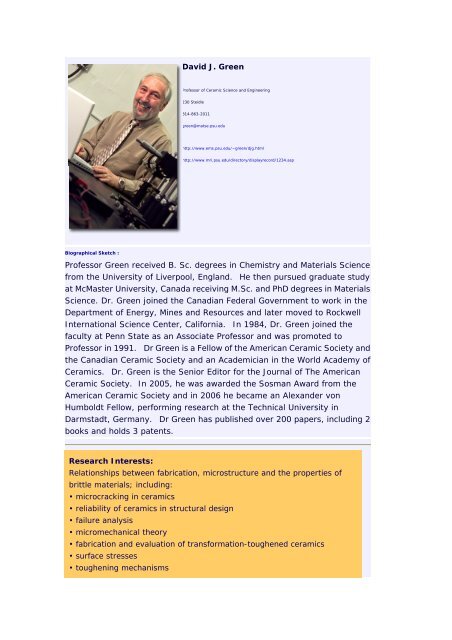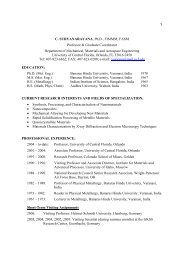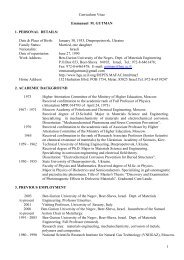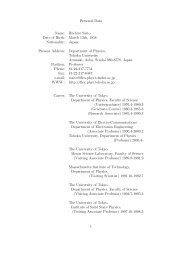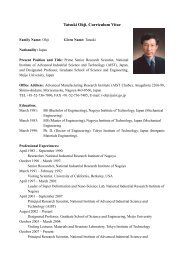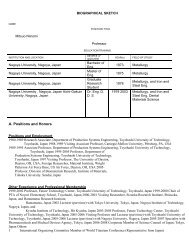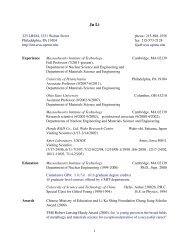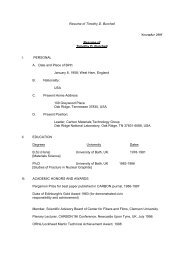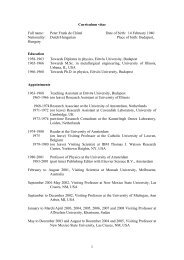David J. Green Professor Green received B. Sc. degrees in ...
David J. Green Professor Green received B. Sc. degrees in ...
David J. Green Professor Green received B. Sc. degrees in ...
You also want an ePaper? Increase the reach of your titles
YUMPU automatically turns print PDFs into web optimized ePapers that Google loves.
<strong>David</strong> J. <strong>Green</strong><br />
<strong>Professor</strong> of Ceramic <strong>Sc</strong>ience and Eng<strong>in</strong>eer<strong>in</strong>g<br />
230 Steidle<br />
814-863-2011<br />
green@matse.psu.edu<br />
http://www.ems.psu.edu/~green/djg.html<br />
http://www.mri.psu.edu/directory/displayrecord/1234.asp<br />
Biographical Sketch :<br />
<strong>Professor</strong> <strong>Green</strong> <strong>received</strong> B. <strong>Sc</strong>. <strong>degrees</strong> <strong>in</strong> Chemistry and Materials <strong>Sc</strong>ience<br />
from the University of Liverpool, England. He then pursued graduate study<br />
at McMaster University, Canada receiv<strong>in</strong>g M.<strong>Sc</strong>. and PhD <strong>degrees</strong> <strong>in</strong> Materials<br />
<strong>Sc</strong>ience. Dr. <strong>Green</strong> jo<strong>in</strong>ed the Canadian Federal Government to work <strong>in</strong> the<br />
Department of Energy, M<strong>in</strong>es and Resources and later moved to Rockwell<br />
International <strong>Sc</strong>ience Center, California. In 1984, Dr. <strong>Green</strong> jo<strong>in</strong>ed the<br />
faculty at Penn State as an Associate <strong>Professor</strong> and was promoted to<br />
<strong>Professor</strong> <strong>in</strong> 1991. Dr <strong>Green</strong> is a Fellow of the American Ceramic Society and<br />
the Canadian Ceramic Society and an Academician <strong>in</strong> the World Academy of<br />
Ceramics. Dr. <strong>Green</strong> is the Senior Editor for the Journal of The American<br />
Ceramic Society. In 2005, he was awarded the Sosman Award from the<br />
American Ceramic Society and <strong>in</strong> 2006 he became an Alexander von<br />
Humboldt Fellow, perform<strong>in</strong>g research at the Technical University <strong>in</strong><br />
Darmstadt, Germany. Dr <strong>Green</strong> has published over 200 papers, <strong>in</strong>clud<strong>in</strong>g 2<br />
books and holds 3 patents.<br />
Research Interests:<br />
Relationships between fabrication, microstructure and the properties of<br />
brittle materials; <strong>in</strong>clud<strong>in</strong>g:<br />
• microcrack<strong>in</strong>g <strong>in</strong> ceramics<br />
• reliability of ceramics <strong>in</strong> structural design<br />
• failure analysis<br />
• micromechanical theory<br />
• fabrication and evaluation of transformation-toughened ceramics<br />
• surface stresses<br />
• toughen<strong>in</strong>g mechanisms
• <strong>in</strong>dentation and fatigue of glasses<br />
• mechanical behavior of porous ceramics.<br />
Areas of research:<br />
Dr. <strong>Green</strong> studies the relationships between the fabrication,<br />
microstructure and mechanical properties of brittle materials, such<br />
as ceramics, glasses and other <strong>in</strong>organic materials. This research<br />
<strong>in</strong>cludes the effect of residual stresses on mechanical behavior.<br />
These stresses can give rise to localized failure <strong>in</strong> composite<br />
structures and lam<strong>in</strong>ates. For example, thermal expansion match<br />
<strong>in</strong> particulate composites often leads to microcrack<strong>in</strong>g. Residual<br />
stresses can also be used to strengthen brittle materials. In recent<br />
work, it was shown that residual stresses could be designed <strong>in</strong> such<br />
a way as to arrest cracks even <strong>in</strong> brittle materials while<br />
simultaneously improv<strong>in</strong>g the resistance to contact damage,<br />
<strong>in</strong>creas<strong>in</strong>g strength and reduc<strong>in</strong>g strength variability. Residual<br />
stresses also play an important role dur<strong>in</strong>g the co-s<strong>in</strong>ter<strong>in</strong>g of<br />
multi-component structures. For example, unless properly<br />
controlled they can lead to damage and distortion dur<strong>in</strong>g<br />
densification and failure dur<strong>in</strong>g cool<strong>in</strong>g after fabrication.<br />
Another important research thrust has been the mechanical<br />
behavior of porous ceramics, such as foams, fibrous and partially<br />
s<strong>in</strong>tered materials. Understand<strong>in</strong>g the micromechanics of the<br />
failure process was the ma<strong>in</strong> emphasis of this work. The research<br />
on porous materials was also extended to understand<strong>in</strong>g<br />
mechanical properties of powder compacts. Other research<br />
<strong>in</strong>terests <strong>in</strong>clude the reliability of ceramics <strong>in</strong> structural design,<br />
failure analysis, fractography and the fabrication and evaluation of<br />
transformation-toughened ceramics. F<strong>in</strong>ally, there has been a<br />
substantial effort <strong>in</strong> study<strong>in</strong>g mechanical deformation <strong>in</strong> <strong>in</strong>organic<br />
glasses, such as <strong>in</strong>dentation, fatigue and viscoelastic deformation,<br />
<strong>in</strong>clud<strong>in</strong>g the effect of coat<strong>in</strong>gs on these properties.


